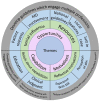A qualitative approach to examining antimicrobial prescribing in the outpatient dental setting
- PMID: 36483419
- PMCID: PMC9726505
- DOI: 10.1017/ash.2022.242
A qualitative approach to examining antimicrobial prescribing in the outpatient dental setting
Abstract
Objective: To understand barriers and facilitators to evidence-based prescribing of antibiotics in the outpatient dental setting.
Design: Semistructured interviews.
Setting: Outpatient dental setting.
Participants: Dentists from 40 Veterans' Health Administration (VA) facilities across the United States.
Methods: Dentists were identified based on their prescribing patterns and were recruited to participate in a semistructured interview on perceptions toward prescribing. All interviews were recorded, transcribed, and double-coded for analysis, with high reliability between coders. We identified general trends using the theoretical domains framework and mapped overarching themes onto the behavior change wheel to identify prospective interventions that improve evidence-based prescribing.
Results: In total, 90 dentists participated in our study. The following barriers and facilitators to evidence-based prescribing emerged as impacts on a dentist's decision making on prescribing an antibiotic: access to resources, social influence of peers and other care providers, clinical judgment, beliefs about consequences, local features of the clinic setting, and beliefs about capabilities.
Conclusions: Findings from this work reveal the need to increase awareness of up-to-date antibiotic prescribing behaviors in dentistry and may inform the best antimicrobial stewardship interventions to support dentists' ongoing professional development and improve evidence-based prescribing.
© The Author(s) 2022.
Figures
Similar articles
-
Barriers and facilitators to guideline concordant dental antibiotic prescribing in the United States: A qualitative study of the National Dental PBRN.J Public Health Dent. 2024 Jun;84(2):163-174. doi: 10.1111/jphd.12611. Epub 2024 Apr 1. J Public Health Dent. 2024. PMID: 38558016 Free PMC article.
-
Barriers and facilitators of evidence-based management of patients with bacterial infections among general dental practitioners: a theory-informed interview study.Implement Sci. 2016 Jan 29;11:11. doi: 10.1186/s13012-016-0372-z. Implement Sci. 2016. PMID: 26821790 Free PMC article.
-
A qualitative exploration of dentists' opioid prescribing decisions within U.S. veterans affairs facilities.Pain. 2023 Apr 1;164(4):749-757. doi: 10.1097/j.pain.0000000000002759. Epub 2022 Aug 17. Pain. 2023. PMID: 35984367 Free PMC article.
-
Uncovering influential factors in human antibiotic prescribing: a meta-synthesis study informed by the Theoretical Domains Framework.J Hosp Infect. 2024 Feb;144:28-55. doi: 10.1016/j.jhin.2023.11.017. Epub 2023 Dec 11. J Hosp Infect. 2024. PMID: 38092303 Review.
-
A Behavioral Analysis of Factors That Influence Antibiotic Prescribing in Hospitals: A Metasynthesis of Reviews.Open Forum Infect Dis. 2024 Dec 17;12(1):ofae728. doi: 10.1093/ofid/ofae728. eCollection 2025 Jan. Open Forum Infect Dis. 2024. PMID: 39781373 Free PMC article. Review.
Cited by
-
Outpatient antibiotic prescribing by general dentists in the United States from 2018 through 2022.J Am Dent Assoc. 2025 May;156(5):382-389.e2. doi: 10.1016/j.adaj.2024.12.003. Epub 2025 Mar 6. J Am Dent Assoc. 2025. PMID: 40047737 Free PMC article.
-
Antimicrobial stewardship strategy implementation and impact in acute care spinal cord injury and disorder units.J Spinal Cord Med. 2025 Jan;48(1):112-128. doi: 10.1080/10790268.2023.2277963. Epub 2023 Nov 20. J Spinal Cord Med. 2025. PMID: 37982811 Free PMC article.
-
Appropriateness of Antibiotic Prescriptions Written for Dental Prophylaxis Within a Regional Veterans Affairs Healthcare System Based on American Dental Association and American Academy of Orthopaedic Surgeons Guidance.Open Forum Infect Dis. 2025 Jul 24;12(8):ofaf432. doi: 10.1093/ofid/ofaf432. eCollection 2025 Aug. Open Forum Infect Dis. 2025. PMID: 40756654 Free PMC article.
-
Research agenda for antibiotic stewardship within the Veterans' Health Administration, 2024-2028.Infect Control Hosp Epidemiol. 2024 Aug;45(8):923-929. doi: 10.1017/ice.2024.6. Epub 2024 Feb 2. Infect Control Hosp Epidemiol. 2024. PMID: 38305034 Free PMC article. No abstract available.
-
Rational Antibiotic Prescribing Is Underpinned by Dental Ethics Principles: Survey on Postgraduate and Undergraduate Dental Students' Perceptions.Antibiotics (Basel). 2024 May 17;13(5):460. doi: 10.3390/antibiotics13050460. Antibiotics (Basel). 2024. PMID: 38786188 Free PMC article.
References
-
- Antibiotic resistance. World Health Organization website. https://www.who.int/news-room/fact-sheets/detail/antibiotic-resistance. Published online July 31, 2020. Accessed November 15, 2021.
-
- Tamma PD, Aitken SL, Bonomo RA, Mathers AJ, van Duin D, Clancy CJ. IDSA Guidance on the treatment of antimicrobial-resistant gram-negative infections: version 1.0. Infectious Diseases Society of America website. https://www.idsociety.org/globalassets/idsa/practice-guidelines/amr-guid.... Published online September 8, 2020. Accessed January 9, 2022.
-
- Fleming-Dutra KE, Hersh AL, Shapiro DJ, et al. Prevalence of inappropriate antibiotic prescriptions among US ambulatory care visits, 2010–2011. JAMA 2016;315:1864. - PubMed
Grants and funding
LinkOut - more resources
Full Text Sources



